GEOGRAPHY Form 2 Topic 3
WATER MANAGEMENT FOR ECONOMIC DEVELOPMENT
Importance of Water
Water is perhaps the most important commodity on earth. There can be no life on earth without water. Therefore, water plays a very crucial role in the very existence of human beings, other animals and all living things, as well as in their activities.
Uses and Economic Importance of Water
Explain uses and economic importance of water
Economic importance and uses of water
- Water is used to clean clothes and other fabrics in homes. On commercial basis, it is used by dry cleaners, capital washing firms and domestic and office cleaning companies
- In manufacturing industries, water is used for various purposes. These include washing raw materials, washing containers and machines, diluting chemicals or ingredients as well as a raw material in industries such as in beverages industries
- Water is also put in several uses in the agricultural sector. Among other uses, it is used to irrigate crops and given to farm animals to drink
- Water is a key component of the electricity
- Water is used for recreational purposes such as swimming. People pay to use facilities such as swimming pools, thus generating income for those who run the facilities
- Water facilitates the growth and development of the fishing industry. This is because water supports the existence of fish in rivers, lakes, ocean or in fish ponds
- People who sell water in estates earn income from this activity. Water provision also generates money for supplying water to homes, offices and industries
The Relationship between Family Size, Water Supply and Quality of Life
Describe the relationship between family size, water supply and quality of life
Households with many family members will obviously require more water to use for various purposes. If the water supply is so acute as compared to family demand, this will lead to water scarcity. In such a case, water turns to be a limited resource. This then affects the quality of life in a various ways such as shortage of water for drinking, washing, cleaning, cooking, etc.
A large family requires more water and hence its members have to spend much time, energy and money to search for and carry water. In rural areas family members, especially girls and women, spend a lot of time and energy searching for water. In some communities girl children are stopped from attending to schools in order to search for water to be used by the whole family. The family may also be required to spend a lot of money to purchase water from vendors, thus limiting the family’s expenditure on other goods and services. This badly affects the quality of life.
For households with a few members, it is easy to manage water resources to make it suffice every member in the household. The quality of life will even be better if that family is well off, in that it can afford to purchase water or even set up water supply infrastructure for own use. A small family on the4other hand, does not require very large amounts of water. Because of its low consumption, such a family is also able to use stored water over a long time in case the frequency of water supply in that locality is low.
WATER QUALITY AND SUPPLY
Water supplied to homes, industries, farms, etc must be of high quality so as to avoid the problems associated with water of poor quality. It must also be free of contamination with microorganisms and/or hazardous chemicals.
Contaminants that may be found in untreated water include microorganisms such as viruses, protozoa and bacteria; inorganic contaminants such as salts and metals; organic chemical contaminants from industrial processes and petroleum use; pesticides and herbicides; and radioactive contaminants. Water quality depends on the local geology and ecosystem, as well as human uses, such as sewage disposal, industrial pollution, use of water bodies as a heat sink, and overuse.
Dissolved minerals may affect suitability of water for a range of industrial and domestic purposes. The most familiar of these is probably the presence of ions of calcium and magnesium which interfere with the cleaning action of soap.
Water supply
Water supply is the provision of water by the government or local authorities, commercial organisations, community endeavours or by individuals, usually via a system of pumps and pipes.
Community water supplies
Community water supplies in Tanzania falls into three categories as explained below:
- Urban water supply, The supplier of water to most cities and towns is the local water and sanitation authority. For example, in Dar es Salaam and Coast Regions, the supplier is the Dar es Salaam Water and Sewerage Authority (DAWASA), which is a parastatal organization. Communities which are situated near towns usually get their water from town water supply. In these communities, the water is pumped from its source which is usually a dam or bore. The water is treated for possible contamination and is then stored in large tanks or reservoirs. From these tanks or reservoirs, a complex system of underground pipes takes the water to the community’s houses, schools, hospitals and other users.
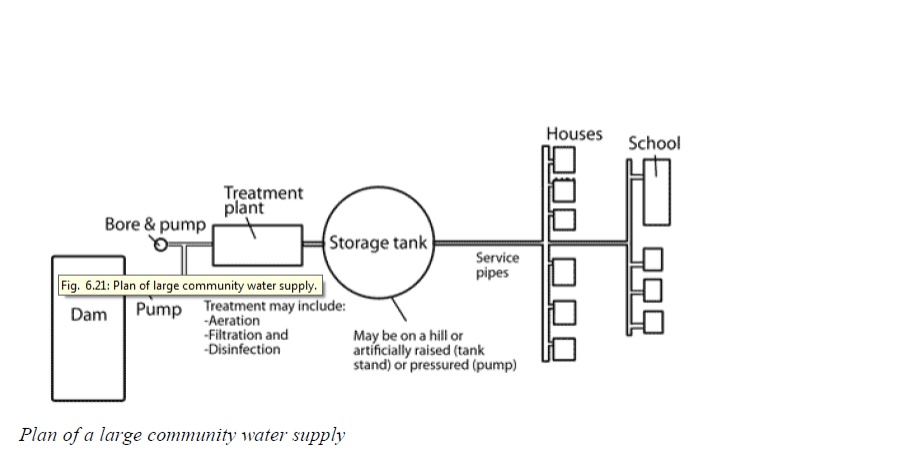
It is the supplier’s responsibility to maintain the water supply equipment. Normally, this will be the water authority. The supplier usually looks after all pipelines to houses and other buildings. Maintenance and repair of water structures in the yard or house is the responsibility of the owner of the house.
- Rural water supply Most communities that are situated away from towns get their water supply from a bore. The bore is sunk in an area where the water is cleanest and most plentiful. Sometimes, water for a rural community is pumped from a river, pool, lake or dam.
The rural community’s water supply is a smaller version of a town water supply. When the water is pumped from the bore it is first treated to make it clean and free of germs. It is then pumped into a storage tank. From the storage tank a network of pipes carries the water to the houses, schools, hospitals, shops, and any other buildings.
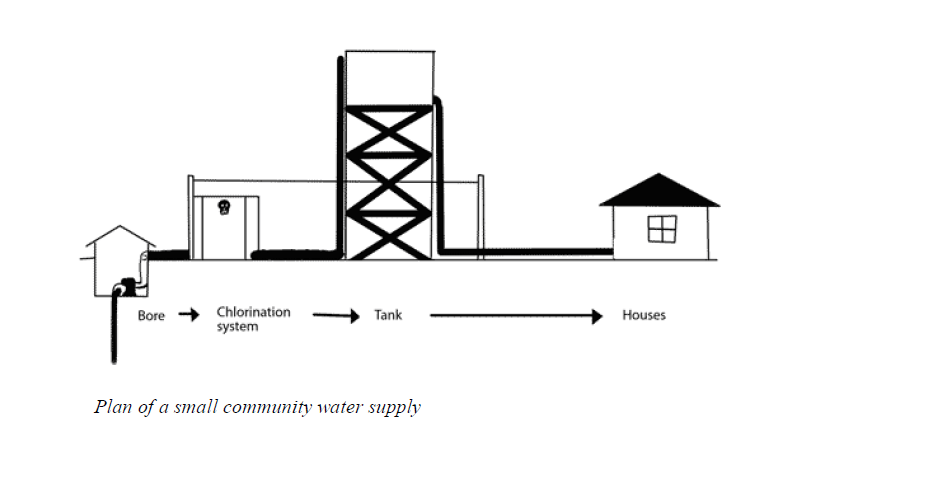
3. The elevated tank Community water tanks can be set on high stands or placed on a nearby hill. The reason is that the elevation (height) of the tank creates the water pressure at the tap. The higher the tank above the taps, the greater is the water pressure at the taps. The maximum (greatest) height for a community water tank is usually 12 metres.
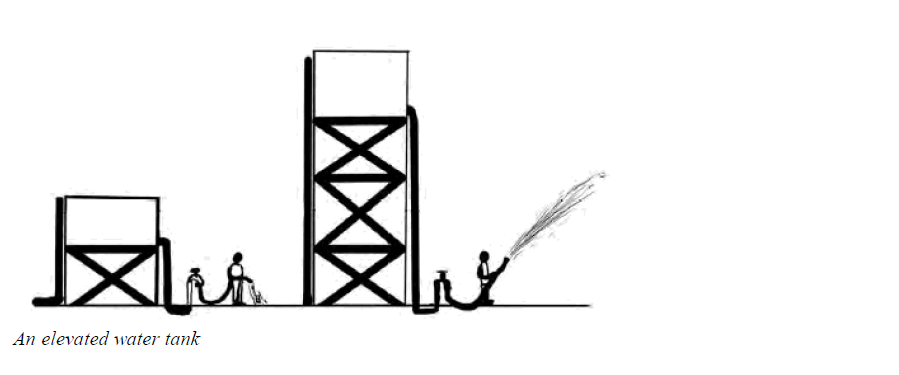
If water pressure at the taps was not created by elevating the tank, the water from the taps and hoses would dribble out very slowly or no water would come out at all, for example, it might take an hour to fill a 20-litre bucket or it might be impossible to have a proper shower.
- Continuity of water supply Continuity of water supply is not a problem in most developed countries, but is a severe problem in many developing countries, where sometimes water is only provided for a few hours every day or a few days a week. It is estimated that about half of the population of developing countries receives water on an intermittent basis.
- The consequences of water quality and supply A safe, reliable, affordable, and easily accessible water supply is essential for good health. An inadequate water supply prevents good sanitation and hygiene. Consequently, improvements in water supply enhance public health. An outbreak of diseases like cholera, dysentery, typhoid and diarrhoea often occur during the time when the water supply is very limited such that adequate sanitation cannot be achieved.
Water supply issues have specific adverse effects on women in developing nations such as Tanzania. Women are often the primary family members responsible for providing water as well as collecting it. This makes female members of the community spend most of the time searching for water, thus preventing them from participating in other economic activities. Sometimes girl children are stopped from attending schools so as to fetch water for the family.
In places where the water supply is low, residents have to spend a lot of money on purchasing it, erecting water infrastructures such as storage tanks as well as much effort in searching for water. This deprives people of time to participate in other income-generating activities. Also the money that could otherwise be spent on other life aspects is directed towards solving water scarcity. This may lead to abject poverty for those families with low income.
All these problems indicate that water quality and supply have a lot of negative implications to the community. So provision of ample and quality water by the responsible authorities is inevitable.
The Relationship between Vegetation and Water Supply
Explain the relationship between vegetation and water supply
The availability and quality of water in many regions of the world are more and more threatened by overuse, misuse and pollution. Both water availability and quality are strongly influenced by forests. Moreover, climate change is altering forest’s role in regulating water flows and influencing the availability of water resources. Therefore, the relationship between forests and water is a critical issue that must be addressed keenly.
- Areas with dense forests and other thick vegetation serve as water catchments. Many rivers and streams have their sources in forests. Examples of rivers originating from forests are the Congo (Congo forests) and Mara (Mau forest in Kenya). This water is what feeds streams, rivers and lakes from which we get water for domestic and industrial uses.
- Places with abundant vegetation stand a chance of getting reliable water supply compared to those with little or no vegetation. This due to the fact that forests form water catchment areas and they also attract rainfall. Forested lands normally receive high rainfall per year than dry and bare lands.
- Governments and international and local organizations encourage people to plant more trees and conserve natural forests so as to prevent the occurrence of drought and hence limited water supply to the community. It is therefore important to ensure that everybody is involved in forest conservation in one way or another so as to maintain water supply.
- There is a very close relationship between water supply and forests. Forests will only thrive on a land that receives sufficient water. At the same time, places with many thick forests often receive high rainfall. Therefore, to be sure of adequate water supply, forest conservation is a must. Where there is little water available, vegetation is very sparse and poor.
How Distance to Water Sources from Household Affects the Girl Child
Explain how distance to water sources from household affects the girl child
Lack of accessible, sufficient, clean and affordable water supply has adverse impacts specifically related to women in developing nations. In Tanzania, women and girl children are mainly the ones responsible for fetching water from wells, rivers, streams, community water supply, etc. The fetching of water, which may take up to six hours a day to meet the household needs, is a duty often assigned to women and children. This foregone time often prevents children, especially girls, from attending school and women from pursuing small business opportunities.
The distance between home and the water source affects the girl child in the following ways:
- When the distance is long, the girls have to walk long distances, sometimes in harsh weather conditions such as hot sun, rains and coldness. Thus, they get tired and sometimes affected health wise by adverse weather. On the way to and from the water sources, they can also be attacked by dangerous animals such as lions and hyenas, bitten by poisonous snakes or even get molested, raped and abused in various ways. Because they spend much time on the way, this means that they have little time to study, play or socialize with their contemporaries.
- If the distance between home and water source is short, the girl children will take a short time to get the water and have enough time to play or take part in other activities. So they will not get very tired. Those studying will have ample time to study and revise or help their parents to do other activities.
Therefore, it is crucial that the government and local authorities do whatever it takes to improve the water services so that water can be obtained from sources close to households. This will reduce or eliminate all the hardships facing girl children in search of water for their families.
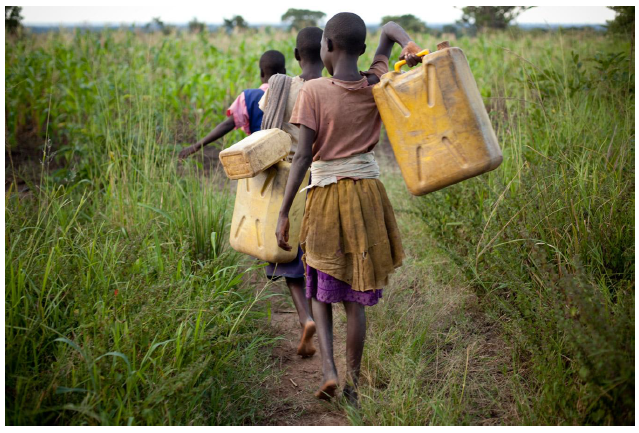
River Basin Development
River basin development projects are schemes developed for different purposes, also they are called multipurpose schemes because they are aimed at meeting many goals like flood control, water supply in the industries and irrigation schemes. Examples of river basin developments are Rufiji River Basin Development and Kilombero Basin Development found in Tanzania, others examples are Tennessee Valley Project in the U.S and the Amazon Basin Development scheme in Brazil. River basin developments involve processes such as construction of dams for retaining water, dredging of the river so as to remove silt and mud from the river.
- Also clearing of vegetation where economic activities are going to take place.
- Planting of trees on the side of the river so as to prevent soil erosion and check the movement of the surface run-off to prevent flooding.
- Creating some canals and installing the pipes that should be used in irrigation schemes.
Benefits of Developing River Basins
State the benefits of developing river basins
Listed below are the benefits of river basin developments
- They help in control of floods where they are established hence the danger of destruction through flooding is avoided.
- They lead to the improvement of navigation in the respective rivers especially when the dams are constructed.
- Leads to the development of the fishing industry especially after the construction of the dams.
- Water is provided for industrial use and domestic purposes.
- River projects encourage environmental conservation like the control of soil erosion by planting trees.
- Employment is usually created in the river basin development projects, for example fishing and workers in the farms get employment.
- Silt removed from the river during dredging adds fertility to the soil and hence promotes farming.
- Water is also provided in the irrigation schemes hence leading to the expansion of farms and increase in agriculture production.
- They encourage the development of tourism since the dams are used as recreational centers, the gorges and waterfalls for viewing and hence bring foreign currency to the country.
The Organization, Benefits, Problems and Prospects of Rufiji Basin Development Authority (RUBADA) and Tennessee River Valley Authority
Explain the organization, benefits, problems faces and prospects of Rufiji Basin Development Authority (RUBADA) and Tennessee River Valley Authority
1. Tenessee River Valley Authority (TVA)
Tennessee river valley is found in the U.S.A and is a tributary of Ohio river. The government of U.S.A organized the development of the valley with the general aim of solving economic difficulties of the people.
Benefits of the Tenessee Valley Authority (TVA)
Below are the benefits of the Tennessee Valley Authority:
- There has been an increase in water supply for irrigation, domestic use and industrial use.
- Navigation in the Tennessee river has improved such as the commercial freight ships operating in the river.
- Hydorelectric power was made available to many people.
- The floods have highly been controlled.
- The project has created job opportunities for many people.
- Increase on the size of arable land due to soil control.
- Fishing industry has developed due to the construction of dams.
- Provision of hydroelectric power has led to the development of different manufacturing and heavy industries.
Problems facing Tennessee River Valley
Listed below are some of the problems facing the Tennessee Valley:
- Soil erosion can also affect the established Tennessee River Valley project.
- Soil exhaustion due to intensive farming hence poor farming and low yield.
- Water pollution especially by the industries discourages the utilization of water from the river basins for economic development.
- Accumulation of silt in the dams leads to the reduction of the volume of water.
- The outbreak of diseases like cholera due to accumulation of water.
- Unreliable rainfall and excessive evaporation lead to the drying of the river and other water bodies hence economic activities cannot take place easily due to the dryness.
Prospects of the Tennessee River Valley
These are some of the prospects brought by the Tennessee River Valley
- Constructing more dams for retaining water all year round
- Maintaining the roads and modifying them to better standards
- Training the local people on other economic activities like navigation fishing and not to rely on one activity to solve the economic problems of the people
2. Rufiji River Basin Development Authority (RUBADA)
Rufiji basin development is found in Tanzania, the government of Tanzania organized the development to support economic activities of the people.
Benefits of Rufiji Basin
Some of the major benefits of RUBADA include:
- It has promoted the market for the Hydro Electric Power (HEP) from Kidatu power plant.
- There has been flood control.
- The scheme has stimulated the development and maintenance of the railway lines and roads.
- It has lead to the creation of employment opportunities in the valley.
- It has promoted living standards of people through employment.
- The development of towns, for example, new towns like Kidatu, Makambako and Mikumi.
- The authority provides expert advice to the farmers on good farming techniques and solutions to their farming problems.
Problems facing the Rufiji Basin Development
Some of the problems facing the Rufiji Basin Development include:
- Poor labour supply due to rural urban migration.
- Diseases like cholera and malaria affect the farmers such that they fail to contribute effectively in the development of the scheme.
- The climate problems like draught have been affecting water availability, sometimes the volume of water in the river decreases.
- There are transport problems prevailing since the roads and bridges are not well constructed, hence during the wet season the area is not well accessible.
- Expenses will be high since the process need high capital and the government does not have enough capital.
- Low technology knowledge among the local people and hence they need intensive training to get the required knowledge and skills.
- The researches and preliminary plans are taking too long. This will lead to the decline of other small projects because the government is concentrating more on that big project.
Prospects of Rufiji Basin Development
Some of the prospects of the Rufiji Basin Development include:
- More funds have to be solicited from various donors both internally and externally.
- Private sector should be encouraged to invest in the development of the valley, thus good investment climate has to be created in order to attract private investors.
- Construction of more dams for retaining water.
Land Reclamation
The Major Aims for Land Reclamation
Explain the major aims for land reclamation
Land reclamation is the process of creating new land from ocean, riverbeds or lake beds. The main objective is to turn land which was previously unproductive to be productive, to increase the size of arable land for various uses such as: human settlement, establishment of industries and expanding agricultural production.
The Techniques Used in Land Reclamation
Describe the techniques used in land reclamation
Land reclamation can be achieved with a number of different methods. The simplest method involves simply filling the undulating land with large amounts of heavy rock and/or cement until the desired level is attained. The process is called “infilling” and the material used to fill the space is generally called “infill”.
Draining of submerged wetlands is often meant to reclaim land for agricultural use. Deep cement mixing is used typically in situations in which the material displaced by either dredging or draining may be contaminated and hence needs to be contained.
Various techniques are employed in land reclamation. The method chosen for reclaiming the land depends on the state of the land in question. The following are some of the techniques that can be used to reclaim the land:
- Irrigation:Irrigation can be used to reclaim arid and semi-arid lands. An arid land may contain sufficient plant nutrients only that these nutrients are not available to plants unless dissolved in water. Irrigation may be followed by addition of fertiliser if the land does not contain adequate nutrient elements to sustain plant growth. The irrigation can be done on a small or large scale depending on the size of the land and the kind of use into which the land is to be put after reclamation.
- Afforestation and reforestation: Afforestation refers to the act of planting trees on a land that has scant or no vegetation. It is mainly carried out on arid, semi-arid or badly eroded lands. It can also be done to reclaim a swampy land. In such cases, trees that consume a lot of water such as eucalyptus are planted so as to drain the land. Reforestation refers to planting of vegetation on an area whose natural vegetation has become scant or cleared by man.
A forestation is done for four major reasons, among others:
- To create water catchment. As explained early, forests attract rainfall, thus they act as water catchment.
- To prevent soil erosion. In this case, trees protect soil from the impact of direct rain drops as well as wind, both of which protect the soil from erosion by water and wind respectively. In addition, trees help to bind the soil particles firmly so that they are not easily eroded by agents of erosion such as water, wind and animals.
- Forests may be established for the purpose of producing timber or poles for sale or logs for manufacture of paper.
- Forests are known to modify the climate though processes such as evapotranspiration (release of water vapour from plant leaves into the atmosphere). Forests also attract rainfall and hence improve the amount of rainfall that a place receives. Increased rainfall can stimulate crop cultivation and animal husbandry.
Techniques continued
- Drainage:This technique involves digging trenches or channels through which water from swampy lands can drain out, thus helping to dry the land. This makes the land suitable for agriculture or settlement. It may also be used to reclaim land from the sea or lake. In the Zuider Zee project in the Netherlands, dykes were built to block sea water. The water in the enclosure was pumped out using pumps. The land was then rehabilitated by planting reeds to prevent growth of weeds and to further drain the water. The reclaimed land was ultimately used for agriculture.
- Landfill:This refers to the act of levelling the land by filling soil, vegetation, stones or other material in the holes, depressions, trenches or undulating land surface to make it suitable for various uses. Landfill can also involve adding a layer of a fertile soil on top of a barren or unproductive soil to be used for agricultural production. This technique of land reclamation is practiced by countries which lie in desert or arid belts where addition of a fertile soil is followed by irrigation and fertilisation.
- Flushing or acidification:Sometimes the soil may contain excess salts particularly sodium ions. This makes the soil too basic (saline). To make such a soil fit for agriculture, the salts are flushed by passing water through it. Alternatively, the salts can be neutralised by addition of sulphur or sulphuric acid. However, this technique is very expensive. It should only be practiced when necessary.
- Clearing vegetation and controlling pests:Some places consist of dense vegetation covers. Such places often are infested with tsetse flies. One of the methods of controlling tsetse is through clearing of bushes (their breeding grounds). Once the bushes have been cleared, the tsetse are ultimately killed using chemicals or by biological methods. The reclined land can then be used for crop cultivation, livestock keeping or settlement.
Land Reclamation Process in Tanzania
Explain land reclamation process in Tanzania
Various land reclamation efforts have taken place and are still going on in Tanzania. A number of methods are employed to reclaim wasteland, turning it a useful land.
Some of the land reclamation initiatives in Tanzania include the following:
- Irrigation. This is carried out on dry lands found within the Rufiji basin. Water from river Rufiji and its tributaries are used for this purpose. Irrigation is also carried out in dry regions of Singida, Dodoma and Shinyanga.
- Drainage. The land in some parts of the country has been reclaimed by using this technique. For example, parts of Kunduchi and Msasani were reclaimed through drainage in order to obtain land for settlement and other purposes
- Afforestation and reforestation. This is one of the various methods used to reclaim wastelands in Tanzania. Shinyanga region is the best example of the land reclaimed trough afforestation. Under the afforestation programme called Hifadhi Ardhi Shinyanga (HASHI), the government has encouraged planting trees to create forests as well as planting trees in crop farms (agroforestry).17The land which was formerly unproductive is now productive again and can be used for agricultural production, settlement and other economic activities. Also in Kondoa district the land has been reclaimed through afforestation campaign, among other techniques.
4. Clearing of vegetation. This was mainly done by colonialists in miombo woodlands. The vegetation was cleared to get rid of tsetse flies which affected livestock production. The cleared land was used for livestock keeping as well as settlement.
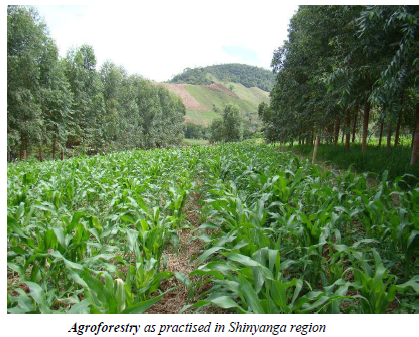
Sustainable Use of Water Resources
The Types of Underground Water and how it can be Tapped for Use at Local and National Levels in Tanzania
Explain the types of underground water and how it can be tapped for use at local and national levels in Tanzania
Water can be found both on the surface of the earth and underground. Underground water also called ground water or subterranean water, is the type of water found below the surface of the earth. Underground water include all water that is found below the earth’s surface, occupying interstices (pores) or voids of pervious rocks and soil. Like surface water, it is derived principally from precipitation that falls upon the earth’s surface and percolates downward under gravity.
Different Resources Obtained from Water
Differentiate different resources that are obtained from Water
Underground water is categorised based on its source as follows
- Connate water: It may also be described as fossil water. This is water trapped in the pores of the rock during the formation of the rock. Connate water can change in composition thought the history of the rock. Connate water is normally saline. Formation water or interstitial water, in contrast, is simply water found in the pore spaces of rock and might not have been present when the rock was formed. This type of water can be found in desert rocks where rainfall does not occur for a long period of time. Connate water generally plays an insignificant role in ground water studies.Agroforestry as practised in Shinyanga region
- Meteoric water:This refers to underground water which originates from rainfall and other forms of precipitation such as hailstorms and snowfall. When the rainfalls or snow melts, a considerable portion of this water gradually infiltrates into the ground. This infiltrating water continues its downward journey to the zone of saturation to become part of the ground water in aquifers (water–bearing rocks).
- Juvenile water:Juvenile water, also described as magnetic water, is water that exists within magma. It is brought close to the earth during vulcanicity. Magnetic water rises from great depth accompanying the magma flow from down the earth’s crust.
- Oceanic water:This is underground water that results from the seepage of ocean water into the ground. It is common in coastal areas where ocean water seeps horizontally into the ground from the ocean.
Underground water can be tapped and put into various uses. The water tapped from the ground can be used for domestic and industrial purposes. Domestic uses include cooking, washing, bathing, watering plants, cleaning and many other uses. Industrial uses may include cooling of machinery, dissolution and dilution of chemicals, beverage manufacture, etc.
Underground water can be tapped in a number of ways which include the following:
- Drilling boreholes:These are holes dug deep into the ground to reach the water table. When the water table or underground water is reached, the water seeps up through the hole under pressure. It is then brought above the ground by pumping manually or using a water pump.
- Digging wells:Just like boreholes, a hole is dug into the ground until water is reached. The difference between boreholes and wells is that water from the well is mainly drawn mechanically using containers such as buckets that are raised mechanically or by use of simple pulleys or hand. The walls of wells may be lined with bricks or stones and cement.
- 3. Where the water occurs very close to the surface, the soil may be scooped to expose the water. The water may then be scooped using cups or other containers. It may be directed to farms for irrigation via channels or trenches. The water may also be pumped and channelled into pipes to provide tap water.
- Underground water may be naturally exposed to form springs or oases in deserts. This water may be scooped directly using containers. It may also be directed to farms through channels.
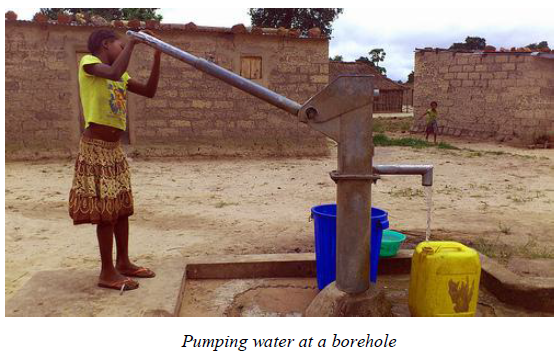
ways to tap underground water
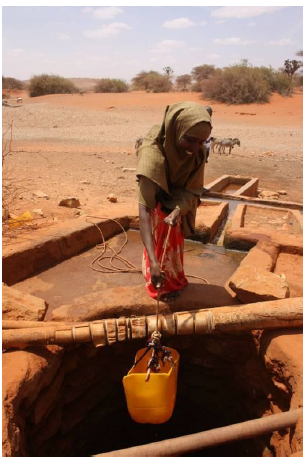
Methods Used for Extracting Resources from Water
Describe methods used for extracting resources from water
Resources obtained from water
There are a number of resources that can be obtained from water. Outlined below are some of the resources that can be extracted from water:
- Fish and other edible creatures, such as crabs and prawns: These resources may be caught either for sale or family consumption.
- Building materials: The building materials obtained from water include sand, coral rock, gravel and clay. Sand can be obtained from beaches of seas or lakes or river valleys and rocks are collected from the sea shore. The rocks and gravel are a result of erosion of the coastal rock by sea waves. Clay can also be obtained from the sea floor or river bed.
- Electricity: Marine wind is used to turn windmills to generate electricity. Hydroelectric power is also a resource from the water since it results from the running water which is used to turn turbines to generate electricity.
- Saltwhich is used at home and in industries, is mainly obtained from sea water though it can also be extracted from salty rivers and lakes.Brick-lined well20
- Ornamental items such as cowrie shells, snail shells, lobster shells, etc are also water resourcessince they come from animals that inhabit water.
- Sea weed is used in many maritime countries as a source of food, for industrial applications and as a fertiliser. High utilisation of these plants as food is in Asia, particularly Japan, Korea andChina, where sea weeds cultivation has become a major industry.
- Limestone and gypsum: Limestone forms from shells of dead marine organisms ranging from molluscs to corals and plants. Limestone can be used directly or converted into cement for construction purposes. Gypsum forms during evaporation of sea water and thus may occur with limestone. The gypsum deposits are mined and generally converted into Plaster of Paris which is mainly used as a building material.
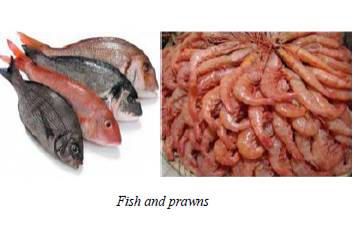
Extraction of resources from water
Many resources are extracted from water and used by man. The following are the means by which thenamed resources may be extracted from the water:
Fish and other edible marine creatures
Fish may be obtained from water through use of a hook and line, nets, herbs, spears or traps. In thecase of a hook and line, bait (such as worm or meat) is attached to a hook which is joined to a stringtied to a long stick or rod. The hook is sunk into the water. When the fish bites the bait, it gets caughtby the hook and pulled out. This method is used for small-scale fishing.
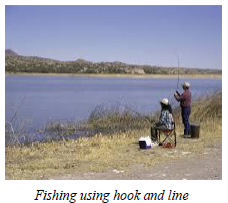
Another method of catching fish is through use of certain plants called tephrosia. This plant ispoisonous to fish. When the leaves of this pea plant are pound and mixed with water, the fish arepoisoned and they fall unconscious and float on water. They are then picked from the water by hand oruse of a spear (harpooning). The fisherman spears fish in water and it is attached to the tip of the spearfrom which it is detached and put in a container.
The traps are mainly used where there are floods or at the coast where there are tides. These traps areset up at the bank of the river or on the beaches. The fish are washed into the banks or beaches by thewater. As the water receded the fish remain trapped behind the traps.
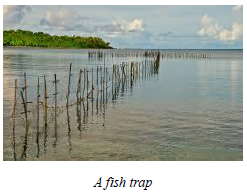
Nets are used to catch a large number of fish. With nets the fish are enclosed in a net with smallperforations through which fish cannot penetrate. They are then hurled to the sea shore, removed fromthe net and put in containers.
Sand
Sand is extracted from the beaches or dredged from the ocean or river beds. This can be done by usingscooping machinery or by hand using shovels, pans, hoes, etc. It is then loaded onto truck or lorryusing shovels or a grab dredge.
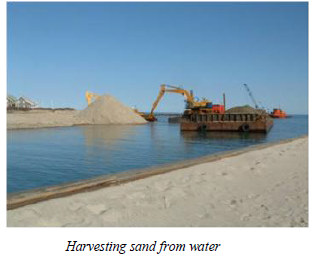
Salt
The process of extraction of salt from water involves evaporation. The salty water is trapped inevaporation ponds. The sun evaporates the water. As the water vapourizes, the salt remains behind.Eventually, enough of the water evaporates to leave behind a layer of salt crystals that can becollected, dried and stored in bags.Another alternative for salt extraction from the water is by means of evaporation tanks. Salty water ispumped into the tanks where the water is evaporated, leaving the salt behind.
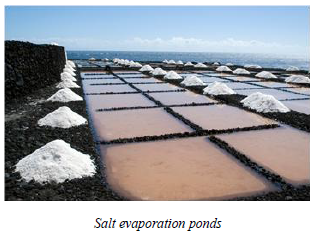
Hydrolectricity
- Hydroelectric power is generated by using turbines that are turned by the fast-flowing river water,where the kinetic energy of the water is transformed into electrical energy.
- Tidal power or marine wind is used to turn windmills to generate electricity. The kinetic energy ofwind is converted into electrical energy by windmills (wind turbines).
Ornamental items
These can be obtained from the sea or lake by picking them using hands. This is normally done duringlow tide and after the water has receded. Ornamental items are brought to the shore from deep sea bythe tides or sea waves.
Seaweeds are harvested by hand-picking. The weeds occur naturally or they can be planted. Limestoneand gypsum are mined by quarrying.
The Problems Caused by Extraction of Water Resources
Explain the problems caused by extraction of water resources
Extraction of water resources may cause various problems and disturbance to ecosystem. Below are some of these problems:
- 1. Overfishing, and indiscriminate fishing whereby even very young fish are caught reduces theavailability of fish resources in water. It also causes an imbalance in the ecosystem.
- Water pollution is a problem where dynamites or poisons are used as methods of fishing.Dynamites produce loud sounds which disturb the fish and other aquatic organisms while poisonkills fish, aquatic plants, and other marine organisms.
- Sand harvesting may lead to loss of media for growth of plant life. It may also disturb aquatic life,for example, it may interfere with breeding of some marine organisms such as monitor lizards,Salt evaporation ponds23snakes, crocodiles, alligators and turtles. These animals normally lay eggs in the sand. Sand extraction from river banks may also lead to flooding since the sand deposited besides a river acts as a levee which prevents water from leaving its channel during floods. It may also accelerate river erosion because the extraction process loosens the soil and makes it easy to erode.
- Harnessing hydroelectric power from river water requires dams to be constructed. This can cause water shortage to the areas downstream. Water trickling from the tank to the nearby areas may also lead to flourishing of disease vectors such as mosquitoes and snails which harbour causative agents for malaria and schistosomiasis respectively.
Some of the solutions to these problems include the following:-
- Giving guidelines on the kind of nets allowed for fishing certain fish species. To achieve this, the fishermen must be closely monitored to ensure that holes of the nets they use for fishing are not too small to catch even young fish.
- Restricting fishing in some parts of the water, especially those areas identified as fish breeding grounds, so as to allow fish to breed and increase in number.
- Encouraging and educating people to practice fish farming so as to reduce fishing pressure on natural water bodies such as rivers, lakes and seas.
- Restricting or controlling sand harvesting in beaches and shores so as to ensure that aquatic environment is not destroyed and that aquatic life is not disturbed.
- Banning the use of dynamites or poisons in fishing because this act pollutes the water and is likely to harm fish consumers.
- Taking stern actions against those people breaching environmental conservation laws. The actions may include fines, jail sentences or both.
Water pollution
Water pollution is the introduction of substances that lower the quality of water bodies such as oceans, rivers, lakes, aquifers and ground water. This makes the water unsafe for use in homes and industries. Water pollution also affects living organisms (plants and animals) living in water.
Water pollution is caused by some or a combination of many factors. The following are some of the major causes of water pollution:
- Agricultural chemicals; Agricultural chemicals that are applied to crops and animals drip onto the soil and may eventually run off into the local streams and rivers. They can also seep down to reach ground water. These chemicals contaminate the water and make it unwholesome for human use and can drastically affect the aquatic life.
- Oil spills; Oil spills in oceans and seas cause water pollution and big problems for local wildlife, fishermen and aquatic organisms. Oil spilled onto land is also carried into water bodies by surface run off. This includes drips of oil, fuel and fluid from motor vehicles, oil spilled onto the ground at filling stations; and drips of oil from industrial machinery. These sources and many more combine together to form continual petroleum pollution to all of the world’s waters.
Mining
Mining causes pollution in a number of ways. They include the following:
- The mining process exposes heavy metals and sulphur compounds that were previously locked deep in the earth. Rain water leaches these compounds out of the exposed earth, resulting in “acid mine drainage” and heavy metal pollution that can continue long after the mining operations have practically ceased.
- The action of rain water on piles of mining waste (tailings) transfers harmful chemicals to freshwater supplies.
- In gold mining, cyanide is intentionally poured on piles of mined rock (a leach heap) to chemically extract the gold from the ore. Some of the cyanide ultimately finds its way into nearby water.
- Huge pools of mining waste slurry (semi-liquid mixture) are often stored behind containment dams. If a dam leaks or bursts, water pollution is likely to take place.
- Mining companies in developing countries sometimes dump mining waste directly into rivers or other water bodies as a method of disposal.
Other pollutants:
- Sediment:The act of clearing the forests to get ample land for agriculture, settlement or wood, leaves the land bare and exposed to the agents of denudation. This accelerates soil erosion and the sediment is free to run into nearby streams, rivers and lakes. The increased amount of sediment running off the land into nearby water bodies seriously affects the fish and other aquatic life. Poor farming practices and cultivation along and close to the rivers, exposes the soil to erosion agents. Soil erosion causes water pollution.
- Industrial Chemicals:Most of the water that is used in the production process in industries is eventually discharged into water bodies. This waste water may contain harmful chemicals such as acids, alkalis, salts, toxic chemicals, oil, heavy metals and even harmful bacteria, and other reagents. These substances affect the quality of water and the lives of aquatic organisms.
- In some cases, the waste water discharged into a water body may be hot enough to kill any organism living in that water.
- Sewage:In developing countries, about 90% of untreated sewage is discharged directly into rivers and streams. This renders the water unwholesome for domestic and other uses. Untreated sewage harbours a myriad of disease-causing organisms. This is the reason why diseases such as cholera, dysentery, typhoid and bilharzias are very common among African countries. Leaking septic tanks and other sources of sewage can contaminate ground and stream waters as well.
- Marine debris: (marine litter) Marine debris is trash in the ocean. This is litter that ends up in ocean, seas or other large water bodies. The debris mainly comes from urban sewers and garbage thrown overboard from ships and boats. Examples of marine debris include plastic bags, water bottles, balloons, shoes, lags etc. It can also include items that wash in from the ocean, such as fishing line, ropes, nets and traps, and items from ship such as lost cargo from container ships.
- Heat:Heat is a water pollutant. Increase in water temperature results in deaths of many aquatic organisms. This is because, as water temperature increases, the amount of oxygen that can dissolve in it also decreases. Therefore, warm and shallow water will contain very little oxygen to an extent that the dissolved gas will not sustain aquatic life.
- This increase in temperature is most often caused by discharge of cooling water (which is always hot) by factories and power plants.
- Global warming also contributes significantly to heating of the oceans.
For resources to be sustainable, they must be conserved to ensure continuity and availability to upcoming generations. Water, as a resource, can be conserved thought the following ways:
- Avoiding wastage:All people should use water wisely to minimise wastage. All taps should be turned off when they are not used. The used water may be re-used again. For example, water that has been used to rinse clothes can be re-used to mob the floor, soak the dirtiest clothes, rags etc. Do not use water directly from the tap, instead fetch the water in a container and use it wisely.
- Controlling polluting: People should neither throw wastes carelessly nor introduce any chemicals into water. Stern laws should be made and enforced to stop industries from dumping toxic wastes into the water bodies. Any industry found polluting the water by any means should be heavily punished or even closed down altogether.
- Protection of water catchment:Vegetation in water catchment areas should be protected and cared for. People should not carry out agricultural activities close to water sources. Planting of trees that consume a lot of water, such as eucalyptus, near water sources or rivers should also be avoided. Any activity that destroys the water catchment should be banned. In the past, the government ordered people to cut down all eucalyptus trees planted close to water sources so as to prevent the water sources from drying up.
- Education:People should be educated about the importance of conserving the water resources. This education can be conveyed thought mass media and introducing water conservation courses in schools and colleges. The government and other organizations concerned with conservation of water resources should involve local communities so as to get maximum cooperation in their endeavours. The local people must be involved at all levels and should be given freedom to suggest how best these resources can be conserved.
- Sewage treatment:Sewage is water containing waste matter produced by people. Much industrial sewage contains harmful chemicals and other waste materials. Sewage must be treated before it flows from sewerage systems into lakes, rivers, and other bodies of water. Untreated sewage contaminates the water and, in time, can kill fish and aquatic plants. The sewage makes the water unsafe to drink and can also prevent use of the water for swimming, fishing, and other recreation. Most cities and towns have at least one sewage treatment plant. In most rural areas, homeowners must provide their own sewage treatment. Most do so with large underground containers called septic tanks or pit latrines.
- Controlled use of agrochemicals:Farmers should be educated on the correct use of agrochemicals. Also agricultural activities should not be carried out in areas close to water bodies. The use of organic manures and chemicals in place of harmful industrial chemicals for agricultural production should be emphasised.
- Recycling of products:People should be advised to recycle the waste instead of dumping it in water sources. This will help reduce the problem of water pollution.8. Immediate clean upWhen oil is accidentally spilled in water it should cleaned up immediately before causing any harm to aquatic life or people using that water. This can be done by use of chemicals or special machines called skimmer ships.
Water Pollution
Many resources are extracted from water and used by man. The following are the means by which thenamed resources may be extracted from the water:
- Fish and other edible marine creatures
Fish may be obtained from water through use of a hook and line, nets, herbs, spears or traps. In thecase of a hook and line, bait (such as worm or meat) is attached to a hook which is joined to a stringtied to a long stick or rod. The hook is sunk into the water. When the fish bites the bait, it gets caughtby the hook and pulled out. This method is used for small-scale fishing.

Pollution
Define pollution
Water pollution is caused by some or a combination of many factors. The following are some of the major causes of water pollution:
- Agricultural chemicals:Agricultural chemicals that are applied to crops and animals drip onto the soil and may eventually run off into the local streams and rivers. They can also seep down to reach ground water. These chemicals contaminate the water and make it unwholesome for human use and can drastically affect the aquatic life.
- Oil spills:Oil spills in oceans and seas cause water pollution and big problems for local wildlife, fishermen and aquatic organisms. Oil spilled onto land is also carried into water bodies by surface run off. This includes drips of oil, fuel and fluid from motor vehicles, oil spilled onto the ground at filling stations; and drips of oil from industrial machinery.
- These sources and many more combine together to form continual petroleum pollution to all of the world’s waters.
Mining
- Mining causes pollution in a number of ways. They include the following:
- The mining process exposes heavy metals and sulphur compounds that were previously locked deep in the earth.
- Rain water leaches these compounds out of the exposed earth, resulting in “acid mine drainage” and heavy metal pollution that can continue long after the mining operations have practically ceased.
- The action of rain water on piles of mining waste (tailings) transfers harmful chemicals to freshwater supplies.
- In gold mining, cyanide is intentionally poured on piles of mined rock (a leach heap) to chemically extract the gold from the ore. Some of the cyanide ultimately finds its way into nearby water.
- Huge pools of mining waste slurry (semi-liquid mixture) are often stored behind containment dams. If a dam leaks or bursts, water pollution is likely to take place.
- Mining companies in developing countries sometimes dump mining waste directly into rivers or other water bodies as a method of disposal.
- Sediment:The act of clearing the forests to get ample land for agriculture, settlement or wood, leaves the land bare and exposed to the agents of denudation. This accelerates soil erosion and the sediment is free to run into nearby streams, rivers and lakes. The increased amount of sediment running off the land into nearby water bodies seriously affects the fish and other aquatic life. Poor farming practices and cultivation along and close to the rivers, exposes the soil to erosion agents. Soil erosion causes water pollution.
- Industrial chemicals: Most of the water that is used in the production process in industries is eventually discharged into water bodies. This waste water may contain harmful chemicals such as acids, alkalis, salts, toxic chemicals, oil, heavy metals and even harmful bacteria, and other reagents. These substances affect the quality of water and the lives of aquatic organisms. In some cases, the waste water discharged into a water body may be hot enough to kill any organism living in that water.
- Sewage:In developing countries, about 90% of untreated sewage is discharged directly into rivers and streams. This renders the water unwholesome for domestic and other uses. Untreated sewage harbours a myriad of disease-causing organisms. This is the reason why diseases such as cholera, dysentery, typhoid and bilharzias are very common among African countries. Leaking septic tanks and other sources of sewage can contaminate ground and stream waters as well.
- Marine debris: (marine litter) Marine debris is trash in the ocean. This is litter that ends up in ocean, seas or other large water bodies. The debris mainly comes from urban sewers and garbage thrown overboard from ships and boats. Examples of marine debris include plastic bags, water bottles, balloons, shoes, lags etc. It can also include items that wash in from the ocean, such as fishing line, ropes, nets and traps, and items from ship such as lost cargo from container ships.
- Heat:Heat is a water pollutant. Increase in water temperature results in deaths of many aquatic organisms. This is because, as water temperature increases, the amount of oxygen that can dissolve in it also decreases. Therefore, warm and shallow water will contain very little oxygen to an extent that the dissolved gas will not sustain aquatic life.
- This increase in temperature is most often caused by discharge of cooling water (which is always hot) by factories and power plants.
- Global warming also contributes significantly to heating of the oceans.
The Main Sources of Water Pollution
Differentiate the main sources of water pollution
There are two major sources of water pollution which are direct and indirect sources. Direct sources includes effluent from factories, refiners and domestic sewage which affect directly water supply systems. Indirect sources include pollution from runoffs, ground water and contaminated rain water. There are other sources such as oil spills and marine or river dumping of waste.
Ways of Conserving Water Resources
Describe various ways of conserving water resources
For resources to be sustainable, they must be conserved to ensure continuity and availability to upcoming generations. Water, as a resource, can be conserved thought the following ways:
- Avoiding wastage:All people should use water wisely to minimise wastage. All taps should be turned off when they are not used. The used water may be re-used again. For example, water that has been used to rinse clothes can be re-used to mob the floor, soak the dirtiest clothes, rags etc. Do not use water directly from the tap, instead fetch the water in a container and use it wisely.
- Controlling polluting:People should neither throw wastes carelessly nor introduce any chemicals into water. Stern laws should be made and enforced to stop industries from dumping toxic wastes into the water bodies. Any industry found polluting the water by any means should be heavily punished or even closed down altogether.
- Protection of water catchment:Vegetation in water catchment areas should be protected and cared for. People should not carry out agricultural activities close to water sources. Planting of trees that consume a lot of water, such as eucalyptus, near water sources or rivers should also be avoided. Any activity that destroys the water catchment should be banned. In the past, the government ordered people to cut down all eucalyptus trees planted close to water sources so as to prevent the water sources from drying up.
- Education:People should be educated about the importance of conserving the water resources. This education can be conveyed thought mass media and introducing water conservation courses in schools and colleges. The government and other organisations concerned with conservation of water resources should involve local communities so as to get maximum cooperation in their endeavours. The local people must be involved at all levels and should be given freedom to suggest how best these resources can be conserved.
- Sewage treatment:Sewage is water containing waste matter produced by people. Much industrial sewage contains harmful chemicals and other waste materials. Sewage must be treated before it flows from sewerage systems into lakes, rivers, and other bodies of water. Untreated sewage contaminates the water and, in time, can kill fish and aquatic plants. The sewage makes the water unsafe to drink and can also prevent use of the water for swimming, fishing, and other recreation.26Most cities and towns have at least one sewage treatment plant. In most rural areas, homeowners must provide their own sewage treatment. Most do so with large underground containers called septic tanks or pit latrines.
- Controlled use of agro-chemicals:Farmers should be educated on the correct use of agrochemicals. Also agricultural activities should not be carried out in areas close to water bodies. The use of organic manures and chemicals in place of harmful industrial chemicals for agricultural production should be emphasised.
- Recycling of products:People should be advised to recycle the waste instead of dumping it in water sources. This will help reduce the problem of water pollution.
- Immediate clean up:When oil is accidentally spilled in water it should cleaned up immediately before causing any harm to aquatic life or people using that water. This can be done by use of chemicals or special machines called skimmer ships.
- READ TOPIC 4: Sustainable Use Of Forest Resources